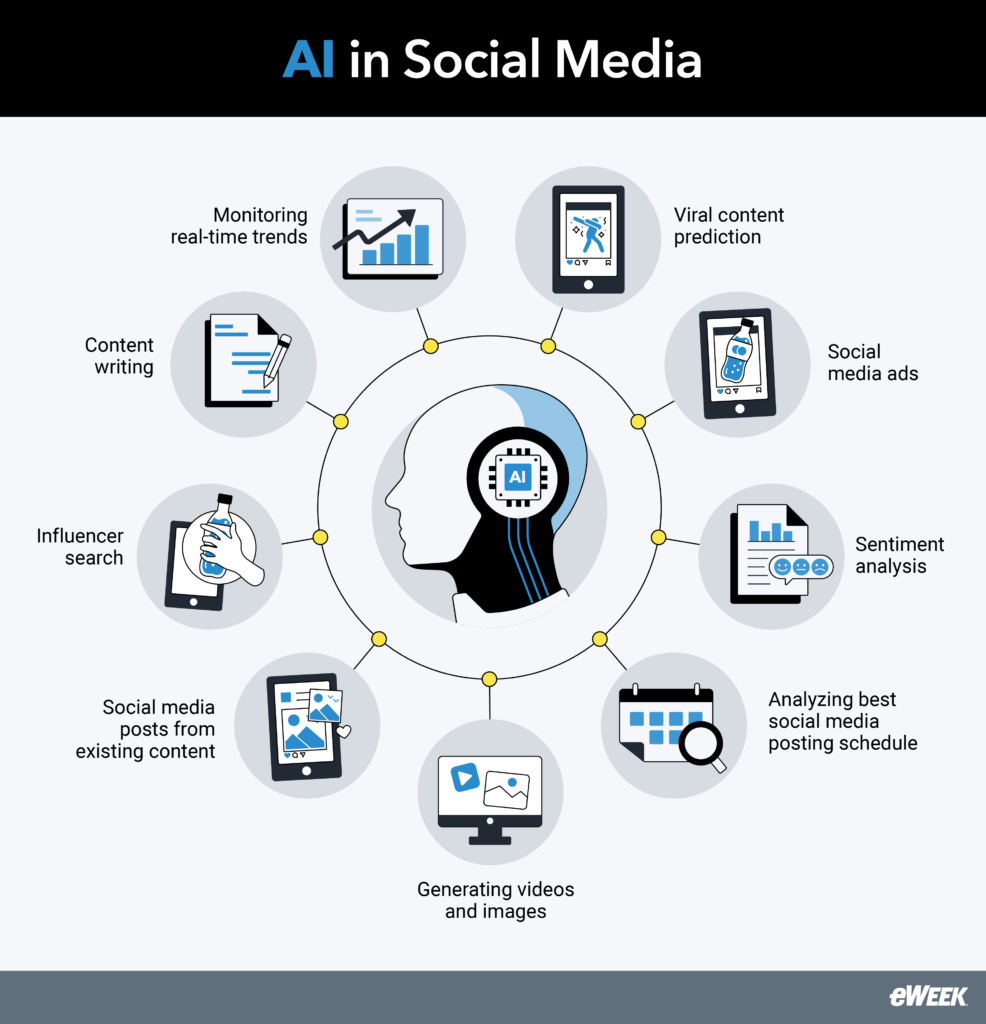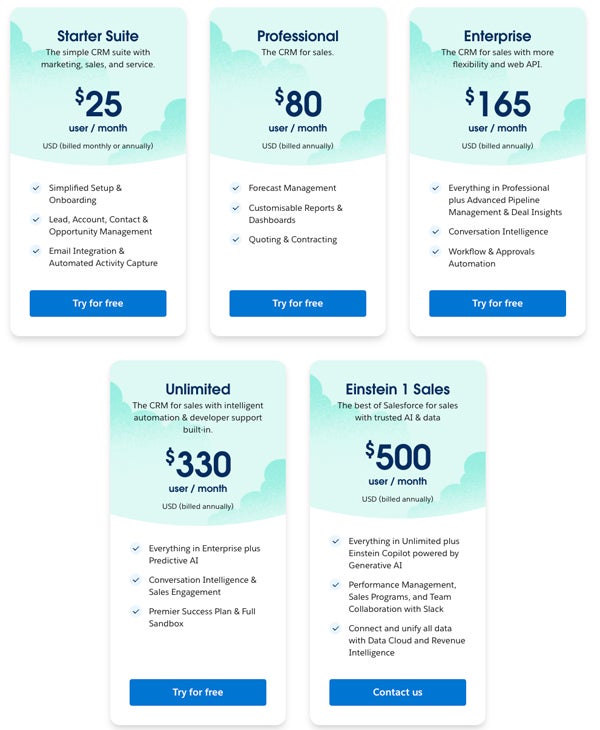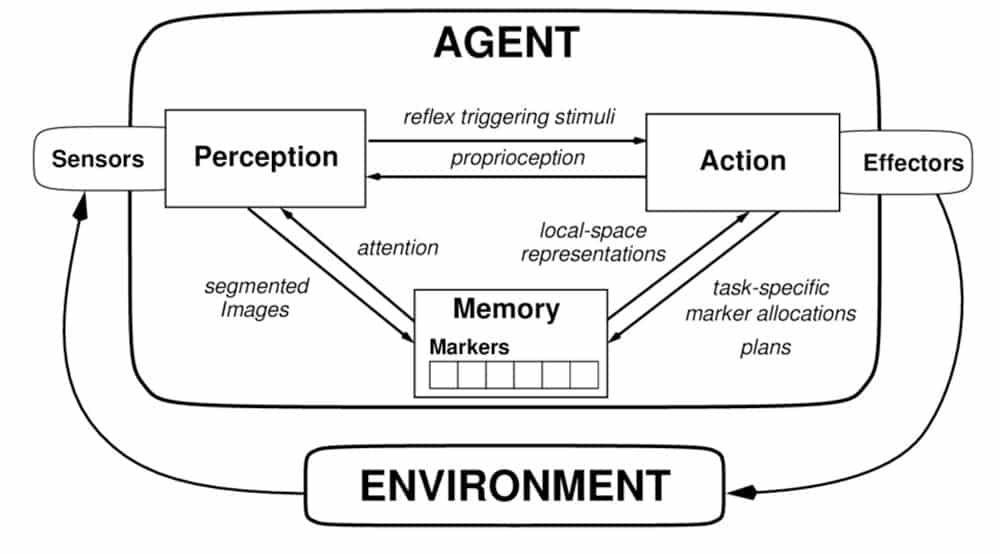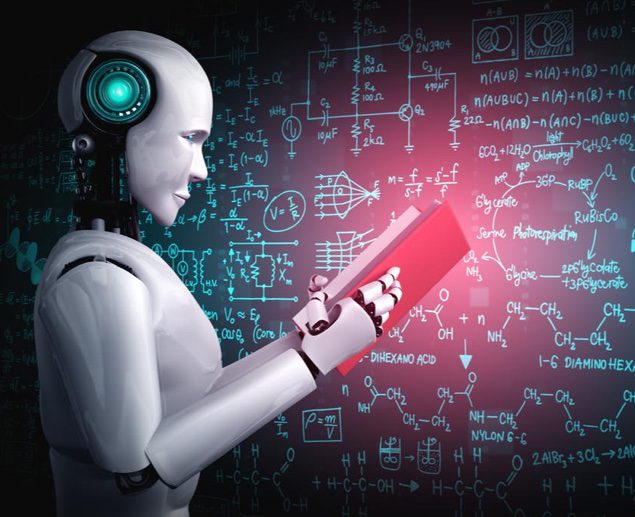Generative synthetic intelligence (AI) is valued for its potential to create new content material, together with textual content, pictures, video, and music. It makes use of AI algorithms to investigate patterns in datasets to imitate fashion or construction to duplicate several types of content material, and can be utilized to create deep-fake movies and voice messages.
Generative AI is a subset of synthetic intelligence, which additionally features a broad vary of applied sciences that allow machines to carry out duties that after required human intelligence and judgment. It’s typically used to construct techniques with the cognitive capability to mine information, and it constantly boosts its efficiency over the course of repeated occasions. Right here’s what that you must find out about the advantages and logistics of utilizing AI and generative AI in addition to the moral considerations of which to bear in mind.
KEY TAKEAWAYS
- •Generative AI focuses on creating new content material, whereas conventional AI focuses on analyzing and deciphering information.
- •Generative AI requires important computational assets and huge datasets, whereas conventional AI could be extra compute environment friendly.•
- •Generative AI use instances are usually in music, design, and advertising, whereas conventional AI use instances are present in finance, healthcare, and manufacturing.
TABLE OF CONTENTS
Toggle
- KEY TAKEAWAYS
- Key Variations Between Generative AI and Conventional AI
- Generative AI: An In-Depth View
- The Way forward for Generative AI
- Conventional AI: An In-Depth View
- The Way forward for Conventional AI
- Moral Concerns
- Prime 3 Programs to Be taught Extra About AI and Generative AI
- Ceaselessly Requested Questions (FAQs)
- Backside Line: Generative AI and AI Have Separate Strengths
Key Variations Between Generative AI and Conventional AI
Each generative AI and synthetic intelligence, generally referred to as “conventional AI,” use machine studying algorithms to acquire their outcomes. Nonetheless, they’ve completely different objectives and functions. Generative AI is meant to create new content material, whereas AI goes a lot broader and deeper—in essence, to wherever the algorithm coder needs to take it. AI’s attainable deployments embody higher decision-making, eradicating the tedium from repetitive duties, or recognizing anomalies and issuing alerts for cybersecurity. The next abstract spells out the widespread variations between generative AI and AI:
- Focus and Output: Conventional AI focuses on analyzing and deciphering present information to enhance effectivity, accuracy, and decision-making because it operates inside predefined boundaries. Generative AI, nonetheless, is designed to create textual content, pictures, music, and fashions primarily based on present information.
- Implementation: Conventional AI is primarily utilized in functions similar to predictive analytics, pure language processing (NLP), and autonomous techniques. In distinction, generative AI is utilized in artistic fields like content material creation, design, and leisure, in addition to scientific analysis the place new hypotheses and fashions are wanted.
- Transparency: Conventional AI fashions are usually extra clear and interpretable. Generative AI fashions, particularly these utilizing deep studying methods, typically operate as “black bins,” making their decision-making processes much less clear.
- Efficiency and Effectivity: Generative AI fashions, notably massive language fashions like GPT-4, require substantial computational assets and coaching time, making it tougher to scale in comparison with conventional AI, which could be extra environment friendly, particularly when coping with particular, well-defined duties that don’t require intensive mannequin coaching.
- Knowledge Necessities and Coaching: Generative AI usually requires massive datasets for coaching to make sure the generated content material is various and high-quality. Conventional AI can typically function successfully with smaller datasets, relying on the complexity of the duty and the mannequin used.
- Adaptability and Flexibility: Generative AI can adapt to varied domains and generate content material throughout completely different fields. Conventional AI, whereas adaptable to some extent, typically wants very particular coaching for every distinctive job or software.
Generative AI: An In-Depth View
To totally perceive the connection between generative AI and AI, it’s needed to know every of those applied sciences at a deeper stage.
Traits of Generative AI
Generative AI is an open-ended and quickly evolving type of synthetic intelligence. Its main traits embody the next:
- Knowledge-Pushed Studying: Generative AI depends on unsupervised or self-supervised studying, figuring out patterns and relationships with out specific labels.
- Generative Fashions: Generative AI makes use of superior fashions like GANs, VAEs, and huge language fashions similar to GPT-3 and GPT-4, designed to create new information just like coaching inputs.
- Creativity and Innovation: A key trait of generative AI is that it might probably generate unique content material similar to textual content, pictures, music, and designs from present information.
- Adaptability: Generative AI adjusts to new information and environments, which continually improves its efficiency. Consequently, it performs an ever wider vary of duties with out builders wanted to explicitly replace its guidelines.
- Unsupervised and Semi-Supervised Studying: Makes use of unsupervised and semi-supervised approaches to study from massive quantities of unlabeled information to cut back dependency on labeled datasets.
Benefits of Generative AI
- Adaptability: These fashions can adapt to new information and constantly enhance their outputs with no need specific rule updates.
- Generalization: These fashions are good at generalizing throughout a variety of duties in a given area as they leverage their discovered information to unravel challenges.
- Knowledge Augmentation: Generative AI simply creates artificial information to enhance present datasets, which is beneficial in data-scarce environments.
- Personalization: As a result of it’s so adept at producing content material, generative AI offers customers customized experiences by crafting content material tailored to particular person preferences.
Limitations of Generative AI
- Lack of Transparency: Opacity is a matter as a result of the interior workings of deep studying fashions could be troublesome to interpret, resulting in considerations about transparency and accountability in decision-making.
- Moral Issues: Generative AI could be misused to generate deep-fake content material and different probably dangerous outputs, fanning moral challenges of misuse and misinformation.
- High quality Management: Ensuring that the generated content material meets high quality requirements could be difficult, particularly since generative AI is infamous for producing false data.
- Bias: Generative AI fashions can inadvertently study and propagate biases current in coaching information to provide unfair outcomes.
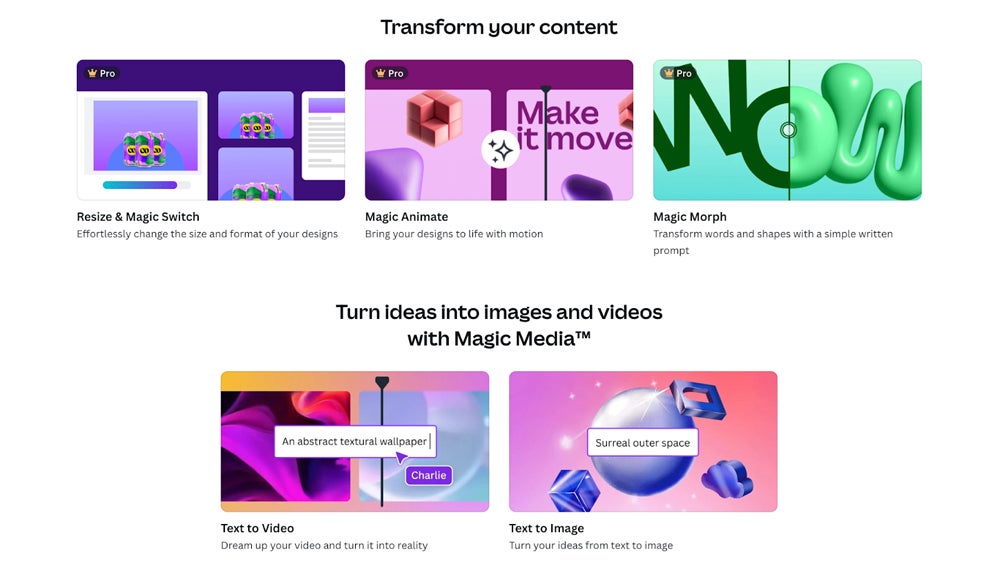 A few of the generative choices in Canva’s Magic Studio.
A few of the generative choices in Canva’s Magic Studio.
Generative AI Use Circumstances
With its potential to make use of supply information for any variety of artistic duties, generative AI’s use instances vary from product design to software program improvement to fraud detection.
Product Design and Personalization
Generative AI helps in creating modern designs that meet particular efficiency standards, from prototyping to optimization of design, whereas minimizing not solely materials use but additionally waste. Moreover, generative AI succeeds at creating extremely customized product experiences by analyzing person information to create merchandise that align with the preferences and wishes of particular person customers. This personalization may help with dishonest advertising and gross sales campaigns.
Artistic Content material Technology
For the artistic industries, generative AI can mimic varied creative types, compose unique music and even generate full items of paintings. This software is increasing the horizons of artistic expression and is being utilized by artists, musicians, and different content material creators to extend their output.
Software program Growth
Generative AI supplies the flexibility to automate code era, bug fixes, and optimization. This ends in extra environment friendly improvement cycles and higher-quality software program. AI instruments can even generate artificial information for coaching and testing functions, which performs an vital position in creating strong AI functions.
Buyer Assist and Engagement
Generative AI-powered chatbots and digital assistants present 24/7 help, personalize interactions, and deal with complicated queries. These instruments elevate buyer satisfaction and operational effectivity by automating routine assist duties and providing sooner responses than human operators.
Fraud Detection and Danger Administration
In finance and insurance coverage, generative AI is used to detect fraud and handle threat. It analyzes transaction patterns and identifies anomalies, then helps in creating detailed studies and summaries that assist in decision-making, thereby enhancing the general safety and reliability of economic operations.
The Way forward for Generative AI
Based mostly on the numerous developments that preserve enhancing generative AI’s capabilities, its future is extremely promising. Count on to see fashions changing into bigger and extra highly effective, like GPT-4 and PaLM2, that are revolutionizing content material creation and customized buyer communications. Such fashions allow companies to generate high-quality, human-like outputs extra effectively, with influence seen throughout many market sectors.
We are able to additionally count on to see generative AI fashions run on a greater variety of {hardware} gadgets, which is able to open up an array of use instances. A notable development is the rise of multimodal AI fashions that may perceive and generate content material throughout a number of types of information, similar to textual content, pictures, and audio. The end result? Customers will get extra immersive and pure person experiences, particularly in fields like digital actuality and augmented actuality.
Moreover, generative AI is driving new ranges of personalization by bettering the way it adapts services and products to particular person preferences. It’s due to this fact seen as a very aggressive driver of change throughout retail, advertising and ecommerce sectors.
 An instance of generative AI: a seaside at dawn created by DALL-E.
An instance of generative AI: a seaside at dawn created by DALL-E.
Conventional AI: An In-Depth View
Though synthetic intelligence has loved an enormously increased profile over the previous few years, the historical past of AI stretches again to the Nineteen Forties. This conventional AI is the premise for generative AI, and whereas there are main variations, there’s main overlap between these two applied sciences. To totally perceive the subject, right here’s a deeper have a look at synthetic intelligence itself.
Traits of Conventional AI
Total, conventional AI is concentrated on specific programming to execute duties with precision. The next are its core traits:
- Rule-Based mostly Programs: Conventional AI depends closely on programming and rule-based algorithms. These techniques comply with predefined guidelines and directions to carry out extremely outlined duties, that means they’re predictable and dependable inside their scope of operation.
- Deterministic Nature: Conventional AI techniques are deterministic, that means they produce the identical output for a given enter each time. This predictability is important for functions similar to fraud detection and medical diagnostics that want constant and correct outcomes.
- Supervised Studying: Conventional AI typically makes use of supervised studying methods, the place fashions are educated on labeled datasets. AI-based functions study to make predictions or selections primarily based on the relationships between input-output pairs.
- Sample Recognition: A core energy of conventional AI is its potential to acknowledge patterns in structured information, which is beneficial in lots of conditions, together with picture recognition, speech recognition, and suggestion techniques.
- Scalability in Nicely-Outlined Environments: Conventional AI techniques are extremely scalable in environments the place duties and information are well-defined and secure. They’ll effectively deal with massive volumes of knowledge and complicated decision-making processes with out important will increase in computational prices.
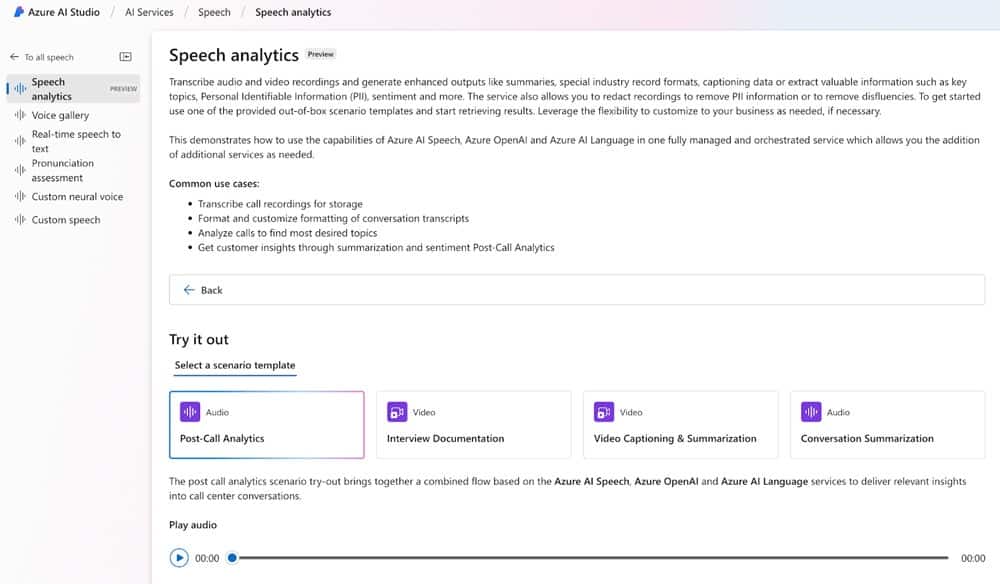 A few of the analytic companies out there in Azure AI.
A few of the analytic companies out there in Azure AI.
Benefits of Conventional AI
- Excessive Accuracy: When given duties with clear targets and structured information, similar to picture recognition and information evaluation, conventional AI achieves distinctive ranges of accuracy.
- Scalability: Conventional AI techniques can deal with better volumes of knowledge or extra complicated decision-making processes with out a proportional enhance in value or assets.
- Transparency: Rule-based AI techniques are usually extra clear and interpretable in comparison with generative fashions.
- Effectivity: Conventional AI fashions are sometimes much less resource-intensive than generative Ai, making them extra accessible for quite a lot of functions.
Limitations of Conventional AI
- Restricted Flexibility: Conventional AI fashions battle to adapt to new, unseen situations, which might hinder their software in dynamic environments.
- Lack of Creativity: Conventional AI is confined to the principles it has been programmed with, that means it can not generate new content material or options past its predefined scope.
- Transparency and Explainability: Whereas typically extra clear than generative fashions, some conventional AI fashions, notably deep studying ones, can nonetheless be opaque.
- Moral Issues: AI isn’t proof against points associated to bias and decision-making processes arising from the information and guidelines a given system is utilizing.
Conventional AI Use Circumstances
Synthetic intelligence can compute exponentially sooner than the quickest group of human specialists, even because it handles far better complexity. This functionality permits an array of use instances, starting from enterprise automation to analysis and improvement to cybersecurity.
Enterprise Automation and Optimization
AI-driven automation is streamlining repetitive and handbook enterprise operations. Robotic course of automation (RPA) makes use of AI to automate routine administrative duties, liberating up human staff for extra complicated actions. AI algorithms are used to optimize provide chain administration by predicting demand, managing stock, and optimizing logistics.
Analysis and Growth
In analysis and improvement (R&D), conventional AI accelerates innovation by analyzing large datasets to establish patterns, predict outcomes, and generate new insights. In prescription drugs, AI helps drug discovery by predicting the efficacy of compounds and optimizing medical trials. In engineering, AI fashions can be utilized to optimize product designs, which helps to decrease the time and price related to bringing new merchandise to market.
Predictive Upkeep
AI is more and more used for predictive upkeep, with use instances like analyzing information from equipment to foretell failures earlier than they happen. This proactive method helps schedule upkeep actions at optimum instances. The advantages embody decrease downtime and prolonged gear lifespans. Industries similar to manufacturing, power, and transportation are the most important beneficiaries of predictive upkeep.
Cybersecurity and Fraud Detection
AI’s position in cybersecurity and fraud detection contains analyzing community site visitors and figuring out potential threats in actual time. AI algorithms detect anomalies and patterns related to cyber assaults, which results in sooner and extra correct responses. AI-driven techniques can automate responses to quite a lot of threats and scale back the danger of breaches and improve total safety.
Monetary Forecasting and Planning
AI-enabled forecasting fashions assist monetary leaders predict future tendencies. AI techniques incorporate variables like combined financial forecasts and non-traditional information sources. It then permits for extra dependable and complete monetary state of affairs planning and extra particular income projections.
 Amazon Fraud Detector as a standard AI instrument.
Amazon Fraud Detector as a standard AI instrument.
The Way forward for Conventional AI
The way forward for AI entails dealing with ever extra complicated and multifaceted real-world situations. Improvements will probably give attention to enhancing the adaptability of rule-based techniques, making them extra versatile and able to coping with unexpected conditions. Count on to see enhanced flexibility and the rise of multimodal techniques able to processing many information varieties concurrently. This may permit AI to deal with extra complicated enterprise challenges throughout a number of domains and considerably broaden its influence.
Self-improving AI techniques are additionally rising. They leverage reinforcement studying and dynamic evaluation for autonomous optimization of efficiency over time. This may additional improve adaptability and effectivity with out fixed human intervention.
The mixing of conventional AI with generative AI is predicted to create hybrid techniques that ship an exponentially extra highly effective mixture. Improvements in AI {hardware} and infrastructure, together with specialised AI processors, will assist these superior techniques. This may permit conventional AI to supply extra refined options throughout an increasing array of use instances.
Moral Concerns
Generative AI and conventional AI face largely related challenges by way of ethics, together with biases constructed into techniques, job displacement and potential environmental influence.
Bias and Equity
AI techniques can inadvertently amplify biases that have been constructed into their coaching information. These biases can result in unfair outcomes, notably for marginalized teams. To make sure equity in AI, whether or not generative or conventional AI, there must be meticulous scrutiny of the coaching information, implementation of bias mitigation methods, and continuous monitoring of AI techniques for biased conduct. Strategies like algorithmic equity opinions and bias audits are a step towards selling fairness and inclusivity in AI functions.
Safety and Privateness
The safety and privateness considerations raised by the deployment of AI applied sciences are pervasive. AI techniques typically want huge quantities of knowledge, together with private and delicate data, to operate successfully. Whether or not generative or conventional, guaranteeing strong information safety measures and sustaining privateness all through the AI lifecycle are vital. This contains implementing robust encryption, information anonymization methods, and complying with laws similar to GDPR. Transparency about information utilization and incorporating person consent can be important in constructing belief and safeguarding privateness.
Transparency and Explainability
For the ever-increasing attain and use instances of AI, we’d like to have the ability to belief AI and maintain the know-how accountable–and plenty of customers don’t belief AI techniques. This belief is enabled by transparency in AI techniques. Explainable AI (XAI) practices permit customers and stakeholders to know how AI algorithms make selections. By offering clear and comprehensible explanations of AI processes, organizations can improve person belief and facilitate higher decision-making. A clear system makes it straightforward to establish and tackle any moral points and to make sure AI techniques are used responsibly.
Job Displacement and Financial Influence
One of many biggest considerations concerning the rise of AI has been job displacement as automated techniques substitute human roles. Assuaging this problem requires methods for transitioning workforces to new or developed roles, similar to reskilling and upskilling applications to organize staff for roles created by AI developments. Organizations want to contemplate the broader social implications of deploying AI options and work to implement practices that strike a steadiness between technological progress and socioeconomic stability.
Environmental Influence
The deployment and coaching of enormous AI fashions, particularly generative AI, requires important computational assets, which results in substantial power consumption and environmental influence. Organizations utilizing AI have to develop and implement energy-efficient AI fashions. In addition they have to optimize computational assets to attenuate carbon footprints. Encouraging sustainable practices in AI improvement and operation is a should for lowering the environmental influence and selling inexperienced AI applied sciences.
Prime 3 Programs to Be taught Extra About AI and Generative AI
Synthetic intelligence in all its kinds is advancing at a outstanding charge, so it’s advantageous for tech professionals to be educated about AI abilities and developments. Listed below are related programs that can assist you use these applied sciences successfully. Please bear in mind that whereas every title beneath refers to generative AI, these programs all educate basic ideas that additionally cowl total AI know-how.
Introduction to Generative AI by Google Cloud
This course supplies a stable basis in generative AI, masking basic ideas, mannequin varieties, and sensible functions. It’s appropriate for many who are new to the sector and wish to discover the potential of generative AI utilizing Google Cloud instruments like Vertex AI.
Go to Google AI Course
Generative AI for Everybody by DeepLearning.AI
Andrew Ng’s course provides a complete introduction to generative AI. It cuts throughout the workings, makes use of, and influence of generative AI in varied industries. The course additionally contains hands-on workout routines for making use of the ideas you study virtually.
Go to DeepLearning.ai Course
Generative AI with Massive Language Fashions by AWS and DeepLearning.AI
Based mostly on a partnership between AWS and DeepLearning.AI, this intermediate-level course goes into utilizing massive language fashions (LLMs) like GPT-4 for generative AI. It covers the structure, coaching processes, sensible functions of LLMs, and extra. The course is designed for information scientists, AI builders, and anybody desirous about mastering LLMs and making use of them successfully of their work.
Go to AWS Course
Ceaselessly Requested Questions (FAQs)
Is Conversational AI the Similar as Generative AI?
No, conversational AI and generative AI are associated however distinct subsets of synthetic intelligence. Conversational AI is designed to work together with customers by means of dialogue, typically utilized in chatbots and digital assistants like Siri, Alexa, or Google Assistant. It focuses on understanding and producing human-like responses to ship significant interactions. Generative AI, however, refers to AI techniques that create new content material primarily based on discovered patterns from present information. Whereas conversational AI can use generative AI methods to present responses, generative AI covers a broader vary of artistic functions past simply dialog.
What’s the Distinction Between Predictive AI and Generative AI?
Predictive AI focuses on analyzing present information to forecast future occasions or tendencies. It makes use of methods like regression evaluation, time sequence evaluation, and machine studying fashions to foretell outcomes similar to inventory costs, climate situations, or buyer behaviors. Generative AI, nonetheless, goals to create new information somewhat than predict future occasions. It makes use of fashions like Generative Adversarial Networks (GANs) and Variational Autoencoders (VAEs) to generate new content material that’s just like the coaching information.
Why Has Generative AI Taken Off So Shortly?
Generative AI has quickly gained recognition because of a number of key elements. The event of refined fashions like GPT-4, GANs, and VAEs has considerably improved the standard and realism of generated content material. Elevated entry to high-performance computing assets similar to GPUs and cloud computing has enabled the coaching of complicated generative fashions. The huge quantity of knowledge out there for coaching these fashions has allowed them to study from various and intensive datasets, enhancing their capabilities. Plus, the wide selection of functions—from artistic industries like artwork and music to sensible makes use of similar to textual content era and artificial information creation—has pushed curiosity and funding in generative AI.
Backside Line: Generative AI and AI Have Separate Strengths
Generative AI and conventional AI every carry distinctive strengths and challenges to the desk. Generative AI is geared for creativity, producing new and modern content material, and is seeing extra integration into fields like artwork, music, and content material creation. In distinction, conventional AI focuses on analyzing present information to enhance effectivity, accuracy, and decision-making, making it invaluable in sectors that worth consistency and predictability similar to finance, healthcare, and manufacturing.
As each these applied sciences proceed to evolve quickly, the variations between them will probably reduce, with generative AI’s creativity and AI’s information crunching energy discovered facet by facet in lots of superior functions.
Learn our information to the Prime 20 Generative AI Instruments and Apps 2024 to study extra about what platforms organizations are utilizing to deploy these dynamic applied sciences throughout their companies.


